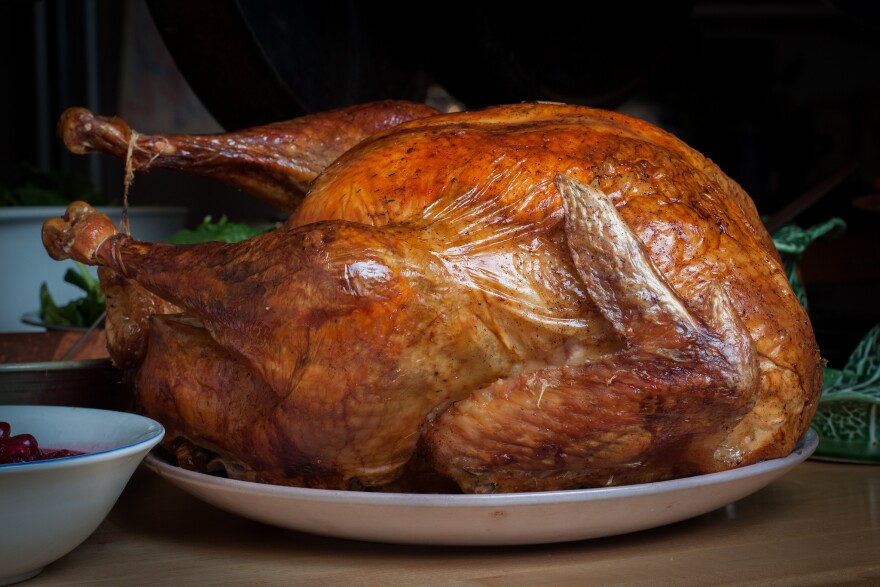Lake Effect essayist Alexandra Rosas comes from a more recent immigrant family – having come here from Colombia in the 1960s. She remembers her family’s first Thanksgiving as assimilating Americans.
It was another bewildering holiday in America for all us, a newly citizened family in the mid 1960′s. We gathered in the kitchen, assembling what we had seen portrayed as necessary in the Sentry Food Store ad insert for a “Thanksgiving Holiday.”
We had the large turkey, the crinkly bag of stuffing-to-be, the boxes of Jell-o to be made, the purple can of Prince yams, the pumpkin pie, ready-made, the cellophane bag of cranberries, and the pop-top can of French’s deep fried onion rings to place atop the green bean casserole.
Yes, we were ready to go. But... why?
We weren’t sure. We were “assimilating” into our new culture, and all that we understood and that our Spanish speaking mother and grandmother understood, was that we had a day off of school to stay home and eat.
A day off of school to stay home and eat. It made no sense, but that is what my siblings and I instructed my mother and grandmother, on what had to be done that day.
I, my two brothers and three sisters were all eagerly shoving black and white sketchings from our school textbooks depicting the First Thanksgiving, into my grandmother’s vision. “See, abuela,” we told her rushedly in Spanish, “see? Here are the Indians eating turkey – see, el pavo? and corn and everything else we have to make here today. We have to. It’s what they do in America.”
“Si, Si…” my grandmother did her best to pretend she understood. But I knew by the sound of her voice, that she had little idea of the purpose of this day.
“I will make this pavo, this turkey, though we never ate this in South America. It is too much like a peacock. We don’t eat peacocks.” We all watched her with anticipation as she rolled the 20 lb bird over and over on the counter. “I wonder how long I shall need to cook something this large for. If I divide it, and quarter it, it shall cook much faster, and then we will be able to fit it into the oven…” she pondered aloud.
“No! Abuela! No!,” we all cried with alarm. “See! See this picture here! With this American family? The turkey is all in one piece! And it’s crunchy brown! You cannot cut it up, Abuela, it must be served whole!”
“I see, I see, ” she pressed her lips together. “Why don’t you, all of you, go and decorate the dining table the way the Americans will do today. I shall see what I can do…”
We widened our eyes at the marvelous suggestion! Yes! Yes! We would decorate the dining table the way the Americans did! Quickly, we all lay on the dining room floor with the day’s newspaper before us. We pored over and scrutinized each picture of a typical American family. Studying and majoring in all things American, we were determined to spend the day as Americans would.
We stared, and then we slowly, one by one, became dismayed. We all seemed to arrive at the realization at the same precise moment. We shook our heads. Who and what had we been trying to become? The pictures we were all looking at were so far from what we looked like. There were drawings of light skinned, blonde haired children. The mother in the picture was a rosy cheeked smiling woman with hair of spun gold, who was entering a room, radiant and proudly carrying a simmering perfectly golden brown turkey on a gilded platter. A turkey that had been left whole.
We were not this family. We would never be this family. We were who we were. We all knew what we had to do.
One by one, we followed each other into the kitchen. We stood and watched our grandmother struggle with how to know what to do with a bird this large. We put our arms around her, smelled her delicious smell of arroz/ rice, with cuminos and aji and cilantro that always hung so comfortingly around her. “Abuela,” we all said, “why don’t you make it the way you know how. It’ll be good the way you know how.”
“Verdad, ninos? Can I?” she asked us in Spanish.
“Si, Abuela, make it like you know we like it,” was our reassuring reply.
“Bueno, Si, I will!” She enthusiastically reached for her long carving knife.
And in that house, on that Thanksgiving, so long ago,while other families dined on perfectly golden whole birds - behind the door at this address, was possibly the first ever sliced and quartered arroz con pavo.
And that felt right to us.
It was who we were, and no one else.
Lake Effect essayist Alexandra Rosas is a contributing author of the HerStories Project as well as other anthologies. She's also Milwaukee GrandSLAM storytelling champion for The Moth, and she lives with her family in Cedarburg.




